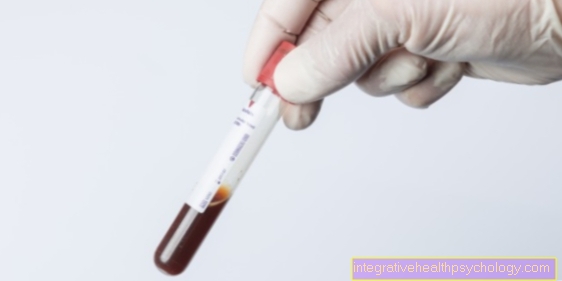Lipase increased
introduction
The value in the blood count that we refer to as lipase is pancreatic lipase. This is an enzyme that is made in the pancreas. It is released into the small intestine to digest fat. The lipase has a reference value of 30-60 U / l. If this value is exceeded, one speaks of an increased lipase.
This value is determined if an acute pancreatitis is suspected, to control chronic pancreatitis and if the upper abdominal pain is unclear.
Read more on the topic: Pancreatitis - How Dangerous Is It?

causes
The causes of increased lipase can be varied. The most well-known cause is inflammation of the pancreas, i.e. pancreatitis.
In the case of acute pancreatitis, the value increases to up to 80 times in the first few hours. It takes over a week for the value to return to normal. It is different with chronic pancreatitis. Here the pancreatic cells die and the lipase is less formed.
Also read: Symptoms of inflammation of the pancreas
Causes for a slight increase
When one speaks of a slight increase, one means that the value only rises to about 5 times the normal value. There are many ways to do this.
Either it is an acute attack of pancreatitis, but it can also remain in the normal range. Even a very early blood test in the case of acute pancreatitis can result in only a slightly increased value at the beginning. In this case, the blood sample should be repeated after a few hours if the symptoms are clear.
Other clinical pictures in which the lipase level can be slightly increased are: ulcers in the stomach or small intestine (ulcer disease), intestinal obstruction (ileus), chronic inflammatory bowel disease, gallbladder inflammation (cholecystitis) due to gallstones, viral hepatitis, kidney failure, in our case very rarely typhoid and mumps, as well as sarcoid with pancreatic involvement.
stress
Stress does not directly affect the lipase value. But there are individual mechanisms for coping with stress that can very well have an influence in some areas.
The most common cause of pancreatitis with increased lipase levels is too much alcohol. So if you tend to consume alcohol because of stress and also eat a lot of fatty foods, you have an increased risk of pancreatitis.
More on this: Consequences of alcohol
What drugs increase lipase?
Opiates increase lipase. These include, for example:
- Morphine
- Oxycodone
- Fentanyl
- Meperidine
- Codeine
Also other drugs like
- Azathioprine
- Bethanechol
- Furosemide
- Heparin
- Indomethacin
- Methacholine
- Methylprednisolone
- Narcotics
- Oral contraceptives ("pill")
- Pentazocine
- Secretin and sulfisoxazole
can increase lipase.
Causes of increased lipase and amylase
In this context we are also talking about pancreatic amylase (alpha amylase). It is important for the digestion of sugar and is produced in the pancreas and then released into the small intestine. If the blood count is high, the first thing the doctor thinks about is an acute pancreatitis.
The amylase is only increased for about 2-5 days, i.e. shorter than the lipase. The normal value of the pancreas-specific amylase is up to 50 U / l. The amylase value is increased more often even without an identifiable cause. It is sufficient to only have the lipase determined if a pancreatitis is suspected, since the informative value here is better than that of amylase.
In the case of increased amylase, the differential diagnoses as in the case of increased lipase are also possible.
If the total amylase is too high (there are amylases from the pancreas and the head salivary glands), then one should also think of diseases such as inflammation of the parotid gland (parotitis).
You can find further information under our topic: Symptoms of inflammation of the parotid gland
Does a high level of lipase indicate pancreatic cancer?
The diagnosis of pancreatic cancer (pancreatic carcinoma) is not made using blood values, but using imaging methods and possibly with a tissue sample.
It is possible that the cancer is accompanied by inflammation of the pancreas, in which case the lipase level can also be increased. Even patients with chronic pancreatitis with acute attacks can, as already described above, show increased lipase values. These patients are at an increased risk of developing pancreatic cancer.
Read more on the topic: Pancreatic cancer- these are the signs!
therapy
The mere increase of the lipase value does not require any treatment. Only as soon as a clinical picture underlies the increase, this disease has to be treated.
The acute pancreatitis is treated in an inpatient, intensive care unit. As a rule, treatment is conservative with pain relievers, volume administration, food abstinence and possibly an antibiotic if there is a suspicion of tissue destruction.
Surgery is only necessary if the disease is severe. If the cause of this inflammation is gallstones, which obstruct the duct of the bile and pancreas, they must be recovered. This is done using an ERCP, an endoscopic retrograde cholangiopancreatography.
Proper nutrition with increased lipase
Since the lipase is produced in the pancreas, an increased level is often associated with a problem with the pancreas. In that case, you want to burden them as little as possible. In the case of an acute inflammation, one usually lies in the hospital and first goes on food abstinence (short-term abstinence from food) and then a gentle diet.
In the case of chronic inflammation, one should eat a low-fat diet so that the pancreas is not overwhelmed. High-fiber foods should also be consumed with caution. It is important to distribute the food in small portions throughout the day. Most important, however, is the complete renunciation of alcohol.
Course of disease
The course of the disease depends on the cause of the increased lipase level. Acute pancreatitis is difficult to predict because the outcome of the disease is closely related to the complications that may occur.
What is certain is that the course can be influenced favorably by going to a hospital early and having intensive medical monitoring carried out there. This allows you to discover possible complications more quickly and, accordingly, to treat them more quickly.
diagnosis
An elevated lipase level is not in itself a diagnosis. It is just a blood value that is not within the normal range. This can have many causes, from a mistake in the measurement method in the laboratory to an acute pancreatitis.
It is best to only have the lipase value determined as a doctor if there is really a reason for it: suspicion of acute pancreatitis, follow-up monitoring of chronic pancreatitis or unclear upper abdominal pain. The diagnosis of the most common cause, acute pancreatitis, should be clarified through further diagnostics (imaging, for example, with an ultrasound).
These symptoms show an increased lipase level
Since the cause of an increased lipase is different, one cannot name general symptoms, but one has to look at the individual clinical pictures that cause an increased lipase.
Acute pancreatitis is accompanied by belt-shaped, severe pain in the upper abdomen. Patients complain of a bloated stomach, nausea, and vomiting. There may also be a fever.
With intestinal obstruction, patients no longer have an appetite, they vomit and feel full. Attack-like pain and stool retention occur.
The chronic inflammatory bowel diseases, including ulcerative colitis and Crohn's disease, cause abdominal pain, blood loss, which can also lead to anemia, diarrhea, abscesses, fever and being underweight. These are systemic diseases; other parts of the body such as eyes, skin, joints and heart can also be affected.
Biliary colic results in cramp-like, often right-sided upper abdominal pain, often fever, mild jaundice and vomiting.
As already mentioned, an increased lipase can also be completely symptom-free and have no disease value.
forecast
If the increased lipase level is the basis of an acute pancreatitis, the patient has a serious illness.
Approx. 1% of patients die from complication-free, correctly treated inflammation. If there are complications such as the death of pancreatic tissue, an encapsulated pus focus (abscess) or blood poisoning, the prognosis is poor. Up to every 4th patient dies of the disease. To assess the risk of death, doctors use a scale, the so-called Ranson score. Acting quickly is an important factor in acute pancreatitis.







-de-quervain.jpg)




.jpg)
















